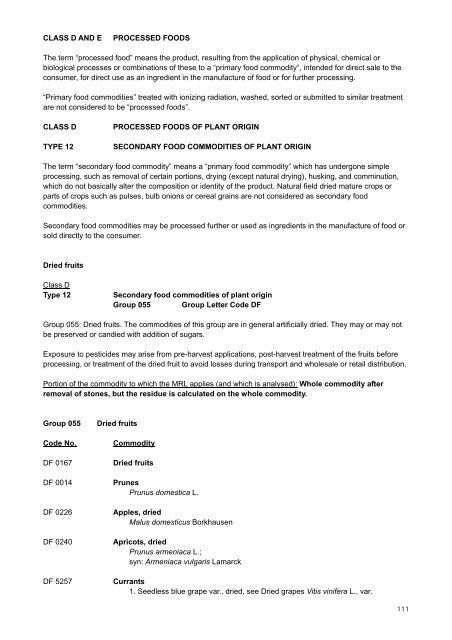codex alimentarius volume 2 pesticides residues in food
codex alimentarius volume 2 pesticides residues in food
codex alimentarius volume 2 pesticides residues in food
You also want an ePaper? Increase the reach of your titles
YUMPU automatically turns print PDFs into web optimized ePapers that Google loves.
CLASS D AND E PROCESSED FOODS<br />
The term “processed <strong>food</strong>” means the product, result<strong>in</strong>g from the application of physical, chemical or<br />
biological processes or comb<strong>in</strong>ations of these to a “primary <strong>food</strong> commodity”, <strong>in</strong>tended for direct sale to the<br />
consumer, for direct use as an <strong>in</strong>gredient <strong>in</strong> the manufacture of <strong>food</strong> or for further process<strong>in</strong>g.<br />
“Primary <strong>food</strong> commodities” treated with ioniz<strong>in</strong>g radiation, washed, sorted or submitted to similar treatment<br />
are not considered to be “processed <strong>food</strong>s”.<br />
CLASS D PROCESSED FOODS OF PLANT ORIGIN<br />
TYPE 12 SECONDARY FOOD COMMODITIES OF PLANT ORIGIN<br />
The term “secondary <strong>food</strong> commodity” means a “primary <strong>food</strong> commodity” which has undergone simple<br />
process<strong>in</strong>g, such as removal of certa<strong>in</strong> portions, dry<strong>in</strong>g (except natural dry<strong>in</strong>g), husk<strong>in</strong>g, and comm<strong>in</strong>ution,<br />
which do not basically alter the composition or identity of the product. Natural field dried mature crops or<br />
parts of crops such as pulses, bulb onions or cereal gra<strong>in</strong>s are not considered as secondary <strong>food</strong><br />
commodities.<br />
Secondary <strong>food</strong> commodities may be processed further or used as <strong>in</strong>gredients <strong>in</strong> the manufacture of <strong>food</strong> or<br />
sold directly to the consumer.<br />
Dried fruits<br />
Class D<br />
Type 12 Secondary <strong>food</strong> commodities of plant orig<strong>in</strong><br />
Group 055 Group Letter Code DF<br />
Group 055: Dried fruits. The commodities of this group are <strong>in</strong> general artificially dried. They may or may not<br />
be preserved or candied with addition of sugars.<br />
Exposure to <strong>pesticides</strong> may arise from pre-harvest applications, post-harvest treatment of the fruits before<br />
process<strong>in</strong>g, or treatment of the dried fruit to avoid losses dur<strong>in</strong>g transport and wholesale or retail distribution.<br />
Portion of the commodity to which the MRL applies (and which is analysed): Whole commodity after<br />
removal of stones, but the residue is calculated on the whole commodity.<br />
Group 055 Dried fruits<br />
Code No. Commodity<br />
DF 0167 Dried fruits<br />
DF 0014 Prunes<br />
Prunus domestica L.<br />
DF 0226 Apples, dried<br />
Malus domesticus Borkhausen<br />
DF 0240 Apricots, dried<br />
Prunus armeniaca L.;<br />
syn: Armeniaca vulgaris Lamarck<br />
DF 5257 Currants<br />
1. Seedless blue grape var., dried, see Dried grapes Vitis v<strong>in</strong>ifera L., var.<br />
111


